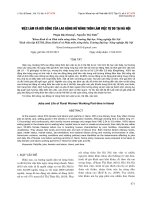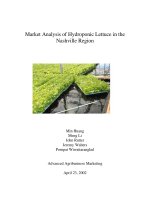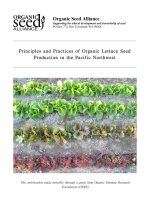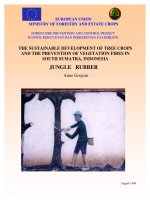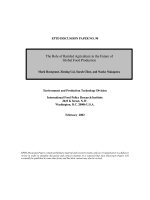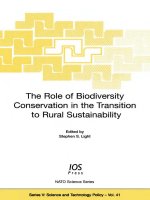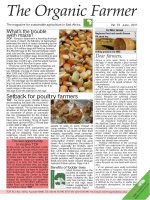Development of Sustainable Agriculture in the Pacific
Bạn đang xem bản rút gọn của tài liệu. Xem và tải ngay bản đầy đủ của tài liệu tại đây (1.7 MB, 17 trang )
DSAP EXPERIENCES
Farmer-Led
Participatory
Project Characteristics
EU funded
It is in 16 countries
Partnership between stakeholders – govt, NGOs, Farmers
• RSC
• Regional
•NSC
•National staff
Development of Sustainable Agriculture in the Pacific
Project Context
Increased intensity of landuse results in:
• Other problems include increased pests and diseases, poor
• deforestation, soil erosion, declining yields, and food insecurity.
agricultural information, and extension deliveries
PRAP the predecessor project addressed these issues and
DSAP became the Extension phase of PRAP
Overall Objective: Increased Sustainable Agricultural Production.
Purpose: Capacity of the NARES, NGOs and farmer groups for
identification and promotion of sustainable agricultural technologies with
farm families improved.
Development of Sustainable Agriculture in the Pacific
(45 attended by 1424)
RA training
or facilitators
16 attended by
219)
Farmer Consultation
Identified problems
and solutions
On-farm demonstration
Training in technical
Skills
(51 attended by 796)
stainable Agriculture in the Pacific
Far from
school
Poor market
structure
Poor sanitation
Unavailability
of lands
Poor soils
Poor
transportation
Pests & diseases
health
tre
Low Animal
productivity
Poor planting
Droughts
materials Poor farming
Skills
Weeds
Poor farm
roads
Farmer and Field Staff
Needs Assessment
Farmer Training
Poor Farming
Skills
Farmer Field
School
On-farm Demonstration
Development of Sustainable Agriculture in the Pacific
Role of ICT
Soil Infertility
P Deficiency
Fe Deficiency
Zn Deficiency
Development of Sustainable Agriculture in the Pacific
Roots restricted
Land clearance - erosion
Toafa Profile
Cover crops
Agroforestry
Contour Barrier
Solutions
Compost
Other Solutions
•Certified organic fertilizers
•Training in diagnosis of nutritional
disorders
•Use of inorganic fertilizers
Sustainable A
Incidence of Pests and Diseases
Taro leaf blight
Caterpillar damages
Pele shoot borer
Taro beetle
Solutions
Training in diagnosis
of PP problems
Organic Production
stainable Ag
Drought and Poor Availability of Water
Bucket
Irrigation
Systems
Scaling up
Solutions
Other solutions:
Use of mulching
Use of composts
Use of appropriate agroforestry
ystems.
Development of Sustainable Agriculture in the Pacific
lthy Planting Materials
Genebank
Poor and
Unavailab
ility
Planting
Materials
and
Genetic
Erosion
Other Solutions
•Introduction of new crops/varieti
•Cultivation of wild varieties.
•Reviving pulaka/babai pits.
inable Agriculture in the Pacific
Animal Production
oultry Production in High School
Breeding Stock
Development of Sustainable Ag
Commodity Pathway
Analysis
Setting up Organic
Farming Systems
Poor Market
Structures
Market Development
Support Development
Of Standards
Development of Sustainable Agriculture in the Pacific
Major lesson learnt:
Involving the people in diagnosing their problems, identifying
solutions to their problems, in the planning of interventions to
heir livelihoods, implementation, and monitoring and evaluation
of the interventions is a first step towards sustainable
ivelihood.
he challenge is how can we instutionalize the approach – that is
hy we have this summit
Impacts
Institutional – at project level it is working
well
- how about after the project
Farmer level – real needs are
identified
Socioeconomics
– some households now have betterpurchasing power
scaling up,
outhealth??
and down?
- nutrition
and
- Gender – women are
involved
Biophysical – improved soil fertility
Improved productivity
-soil and biodiversity conservation
-reintroduction of traditional varieties (broaden genetic
base)
Development of Sustainable Agriculture in the Pacific


